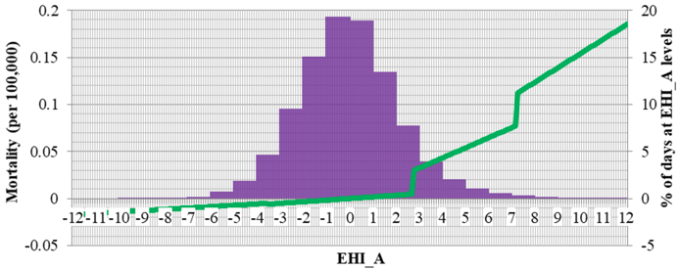A lack of acclimatisation to the heat is an important issue with respect to the impacts of heatwaves on mortality and health service use. It impacts on the human physiological response to heat (Scalley et al. 2015) and whether people are prepared for these extreme temperature events (Nairn and Fawcett 2015).
In a recent paper, I found that a lack of acclimatisation was a key factor that influenced how deadly heatwaves were in five Australian capital cities (Longden 2018). I found that for the period between 2001 and 2015, it was the more southerly cities (which are further away from the equator) that were most severely impacted by heatwaves on a per capita basis.
These heatwaves were severe as they had high three-day average temperatures that were notably different to temperatures during the previous 30-day period. The measure that I used in this research was an excess heat index of acclimatisation (EHI_A), which is the three-day average temperature minus the previous 30-day average temperature. This index is part of the Australian Bureau of Meteorology’s excess heat factor, which is used to predict heatwaves as part of the Heatwave Service for Australia.
Recent heatwaves in the Northern Hemisphere
During the last 15 years, Europe and North America have been struck by some very strong heatwaves. The heatwave of 2015 was notable, with numerous cities recording all-time record maximum temperatures. Beniston et al. (2017) provide examples of cities with record maximum temperatures during the summer of 2015: Madrid (with a maximum temperature of 39.9°C), London (with a max. of 36.7°C), Kitzingen, Germany (with a max. of 40.3°C), Maastricht (with a max. of 38.7°C) and Geneva (with a max. of 39.7°C).
A recent heatwave in Canada was also extreme and was associated with a total of 74 deaths, including 34 in Montreal (Fidelman 2018, Kassam 2018). In this column I will focus on Montreal to explore whether high EHI_A values coincided with the heatwave event in July 2018. My intent is to stimulate interest in the measurement of heatwaves using measures that account for acclimatisation.
Measuring excess heat in Australia
The Australian Bureau of Meteorology uses the Excess Heat Factor to measure and forecast a heatwave’s intensity. It combines two indices: one to measure how hot the three-day average temperature is with respect to a temperature threshold for that location, and the other to measure how hot the three-day average temperature is compared to the previous 30 days. This latter index is the excess heat index of acclimatisation mentioned above, which accounts for acclimatisation and whether people are prepared for an intense increase in heat (Nairn and Fawcett 2015).
An endogenously determined threshold
Rather than estimating a U-shaped relationship between temperature and mortality using time-series data for one region, I utilised an alternative approach to estimating temperature-related mortality. My study used panel data for five Australian cities to find thresholds where the temperature-related mortality relationship was different for higher/lower temperatures. These thresholds were found using a fixed effects panel threshold regression (further details on this approach can be found in my paper).
Figure 1 shows one of the temperature-related mortality relationships I found. There are two thresholds for hotter temperatures that capture the temperature-related mortality relationship for extreme heatwave and other heatwave events. These thresholds are an EHI_A of 7.26ºC and 2.74ºC. Between 2001 and 2015, most of the events above the 7.26ºC threshold occurred in Adelaide, Melbourne, and Perth. Brisbane and Sydney (cities which are closer to the equator) had a lower number of days above the 7.26ºC threshold. Figure 1 also contains a histogram of the EHI_A for these five cities between 2001 and 2015. Note that some heatwaves in Melbourne and Adelaide had values of the EHI_A that were above 12ºC and were associated with a high number of deaths.
Figure 1 Model estimates of the accumulated 16-day temperature-related mortality per 100,000 residents and a histogram of the EHI_A for 5 Australian cities between 2001 and 2015
Source of data: Longden (2018)
Figure 2 EHI_A and other measures of temperature during an extreme heatwave in Montreal during 2018
Source of data: Meteorological Service of Canada.
The excess heat index of acclimatisation during the recent Montreal heatwave
Figure 2 focuses on the temperatures in Montreal during the 2018 heatwave that occurred in early July. In this case, the EHI_A captures the key period of excess heat that was associated with mortality, as reported in the media (Fidelman 2018, Kassam 2018). The EHI_A value surpassed 7.26ºC for five days in a row and reached a maximum of 9.1ºC on 2 July. Also shown in Figure 2 are the maximum, minimum and three-day average temperatures for the same time period. This period coincided with maximum temperatures above 30ºC for seven days in a row and six nights in a row with minimum temperatures above 20ºC.
Implications for future research and heatwave forecasting
While I have not associated the Montreal heatwave with an increase in mortality, this heatwave did surpass the 7.26ºC threshold I found in my research. Future research should focus on heatwave events in other parts of the world (including Europe and North America) to confirm that heightened mortality occurs when the EHI_A measure is above 7.26ºC. The appropriate threshold may be different across regions and this should also be explored.
Confirming whether heatwave forecasts are improved when using an EHI_A threshold will also be important. Note that the Australian Bureau of Meteorology’s excess heat factor does not currently use a threshold for this component of their measure.
Nevertheless, the relationships in Figures 1 and 2 imply that the use of a measure that accounts for a lack of acclimatisation is important. Heatwave forecasting services should consider whether a similar measure that accounts for a lack of acclimatisation should be used in Europe, North America and elsewhere.
References
Beniston, M, M Stoffel and S Guillet (2017), "Comparing observed and hypothetical climates as a means of communicating to the public and policymakers: The case of European heatwaves." Environmental Science & Policy 67: 27-34.
Fidelman, C (2018), "As second heat wave gains steam, 74 deaths are linked to Quebec weather", Montreal Gazette.
Kassam, A (2018), "Canada heatwave: more than 30 deaths reported as extreme weather continues", The Guardian.
Longden, T (2018), "Measuring temperature-related mortality using endogenously determined thresholds", Climatic Change. doi.org/10.1007/s10584-018-2269-0
Nairn, J and R Fawcett (2015), "The Excess Heat Factor: A Metric for Heatwave Intensity and Its Use in Classifying Heatwave Severity", International Journal of Environmental Research and Public Health 12(1): 227.
Scalley, B D, T Spicer, L Jian, J Xiao, J Nairn, A Robertson and T Weeramanthri (2015), "Responding to heatwave intensity: Excess Heat Factor is a superior predictor of health service utilisation and a trigger for heatwave plans", Australian and New Zealand Journal of Public Health 39(6): 582-587.





